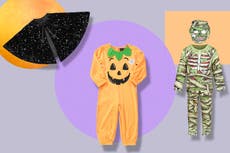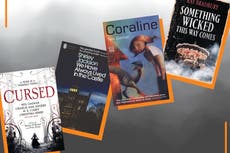What do blue or teal Halloween buckets mean?
Teal trick-or-treat buckets are used to indicate that a house is safe for those with food allergies
With the night for trick-or-treating officially here, there may be different coloured pumpkin buckets spotted among the sea of orange ones - and they have a special meaning.
Teal pumpkins, whether they are used to hold candy or for decoration, are often used as an indication that a house is food-allergen-friendly - and that non-food treats such as glow-sticks or stickers will be given out to trick-or-treaters. The Teal Pumpkin Project was first started in 2014 by Food Allergy Research & Education - with the goal to raise awareness of food allergens on Halloween.
According to the website, a teal pumpkin placed on a doorstep is a symbol of “safety, inclusion and respect of individuals managing food allergies”. The campaign, which has since become a global movement with thousands of homes participating each year, also aims to make trick-or-treating “more inclusive for the one in 13 children living with food allergies, and many others impacted by intolerances and other conditions”.
There has since been an additional meaning for pumpkin buckets of a similar colour, as blue ones when trick-or-treating can be used by children to indicate that they have autism. As noted by the National Autism Association, the meaning behind the blue buckets was first shared by mother Alicia Plumer on social media.
“If you see someone who appears to be an adult dressed up to trick-or-treat this year carrying this blue bucket, he’s our son! His name is BJ & he is autistic. While he has the body of a 21 year old, he loves Halloween,” she posted on Facebook, as noted in a blog post shared by the National Autism Association. “Please help us keep his spirit alive & happy. So when you see the blue bucket share a piece of candy. Spread awareness! These precious people are not ‘too big’ to trick or treat.”
At the time, Plumer’s post received a lot of attention from fellow parents who have children with autism, and Target even partnered with the National Autism Association in 2020 to sell blue Halloween buckets. The organisation’s blog post also acknowledged that the buckets could be helpful for children of all ages with autism, “especially for the more severely affected kids who are nonspeaking, and for older kids who may appear to function at a lower cognitive age level”.
“Some kids can’t say ‘Trick or Treat’ or ‘thank you,’” the post reads. “They may not be able to make eye contact, and could also have sensory issues that prevent them from wearing an elaborate costume.”
According to the NHS, people with autism tend to have problems with social interaction and communication.
However, the buckets have also been viewed as controversial over the years. The National Autism Association acknowledged that “some strongly disagree with the practice, citing that it sets our kids apart and could even make them a target for abuse”.
Ultimately, just like every Halloween, parents can still decide for themselves if they want their children to use the blue buckets when trick-or-treating.
Join our commenting forum
Join thought-provoking conversations, follow other Independent readers and see their replies
Comments


Bookmark popover
Removed from bookmarks